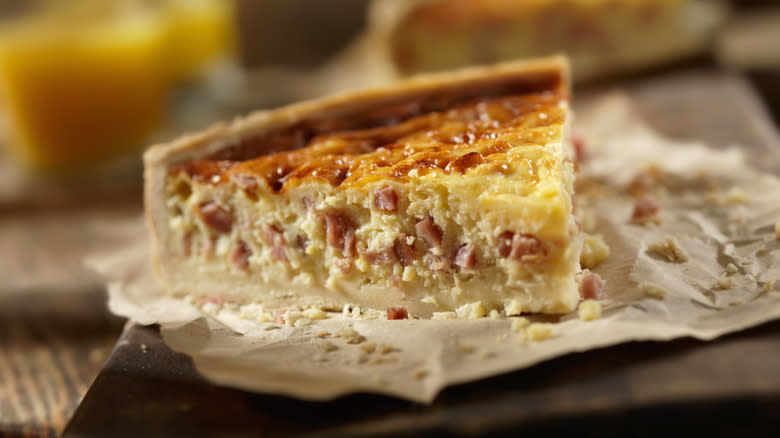How Quiche Lorraine Got Its Iconic Name

Have you ever wondered who "Lorraine" is when you hear "quiche Lorraine?" We're serving up some answers for curious foodies with an appetite for history. Per popular lore, quiche Lorraine started as a rustic Provençal dish in the kitchens of home cooks in northeastern France. It's widely accepted that this centuries-old dish originated in the namesake Alsace-Lorraine region, but this isn't where the egg pie's story begins.
Quiche Lorraine might have been brought to France by German immigrants from the medieval kingdom of Lothringen. Unpacking the history of quiche Lorraine is also a crash course in the history of Europe itself. The cooks who first made quiche Lorraine were likely speaking a Germanic language before the country Germany had even been established yet.
The Holy Roman Empire lasted from 800 to 1806 B.C.E. and the beginning of the era was characterized by the predominant practice of Frankish and Germanic cultural elements. The first Holy Roman Emperor was Frankish, then German, and the Empire itself encompassed a wide stretch of many yet-to-be-established countries across western and central Europe. Many regions belonging to the Holy Roman Empire (Alsace and Lorraine included) spoke some version of German.
When the Prussians (who would later become the Germans) won the Franco-Prussian war in 1871, Alsace-Lorraine was annexed and the region officially became German, along with its savory quiche. Then, in the early 1900s, after WWI broke out, Alsace-Lorraine was annexed to France and has remained French ever since.
Read more: 25 Most Popular Snacks In America Ranked Worst To Best
Franco-Germanic Roots And Multicultural Ingredients

Modern quiche Lorraine brings together bacon, cheese, cream, and a touch of nutmeg in a plush egg souffle, all married in a flaky pie crust. Perhaps that assembly is part of the reason why the word "quiche" bears strong etymological ties to the German word "kuchen," meaning "cake." But, early home cooks must have gotten it right the first time because quiche Lorraine has enjoyed a fairly faithful evolution over the years. Proto-versions are thought to have included cream, eggs, and smoky bacon, with cheese not being added until later on, and when it was, it was cheese stemming from the French influence: tangy Gruyère. French Emmental cheese is also popular, and onions are also sometimes added. Although technically speaking, if you add onions to a quiche Lorraine, it becomes quiche Alsacienne.
Early quiche Lorraine might have originally included smoked pork lardons instead of bacon. This ingredient is another example of French influence, as lardons remain a popular ingredient in much of French cuisine like tartiflette, salade frisée, chicken Provençal, and boeuf bourguignon. Hungry for a taste of the past, or just for a humble, nourishing meal? This elevated comfort food is accessible to beginner home cooks and impressive enough for pros to serve with confidence. It makes for a great brunch with a lightly dressed arugula salad and a Bloody Mary.
Read the original article on Tasting Table.

